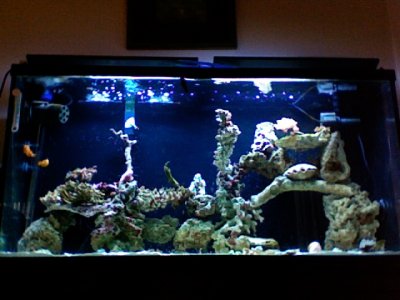tobesonthenose
New member
I am really interested in getting a mantis shrimp and have been doing much research online and on "Roy's List". I have a 60g GLASS tank that is about 4' long x 2ft tall x 1' deep. It has an HOB filter and hob protein skimmer. No overflow or sump. (Marineland tank from Petsmart).
I would like a very active and interactive species that will be out of its den and utilizing much of the available space in the tank for foraging and lurking around. I would like the mantis to be the focal point of the tank and be out and about often.
I fear a peacock may chip my glass when it gets big so I would like one that is big but not big enough to damage tank. My finalists are a G. smithii (purple spot)or a Pseudosquillis ciliata (yellow mantis). Other suggestions welcomed too.
I know every mantis personality differs but if you have owned either or both of these species i would greatly appreciate your thoughts and comparasons.
I attached a pic of my tank. I figure i will rearrange some rock to provide a cave/den for it.
Also I have 2 Ocellaris clowns, one very large hermit (about the size of a tangerine), random small hermits and snails.
If it is highly likely one of these species will kill the fish I could rehome them before getting the mantis.
I am under the impression that generally the spearer can live with snails and crabs but not fish, and the smasher can live with fish rather than snails and crabs. I suppose if that is true I would rather have a clean up crew as opposed to having fish without a cuc.
Would the large hermit likely be killed by either of these even if the hermit is bigger than the mantis.
Sorry for so much info and rambling, really looking forward to getting one of these but just want be well prepared.
Thanks for your time
I would like a very active and interactive species that will be out of its den and utilizing much of the available space in the tank for foraging and lurking around. I would like the mantis to be the focal point of the tank and be out and about often.
I fear a peacock may chip my glass when it gets big so I would like one that is big but not big enough to damage tank. My finalists are a G. smithii (purple spot)or a Pseudosquillis ciliata (yellow mantis). Other suggestions welcomed too.
I know every mantis personality differs but if you have owned either or both of these species i would greatly appreciate your thoughts and comparasons.
I attached a pic of my tank. I figure i will rearrange some rock to provide a cave/den for it.
Also I have 2 Ocellaris clowns, one very large hermit (about the size of a tangerine), random small hermits and snails.
If it is highly likely one of these species will kill the fish I could rehome them before getting the mantis.
I am under the impression that generally the spearer can live with snails and crabs but not fish, and the smasher can live with fish rather than snails and crabs. I suppose if that is true I would rather have a clean up crew as opposed to having fish without a cuc.
Would the large hermit likely be killed by either of these even if the hermit is bigger than the mantis.
Sorry for so much info and rambling, really looking forward to getting one of these but just want be well prepared.
Thanks for your time

